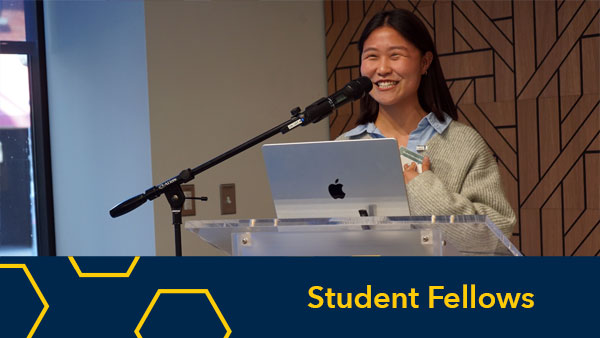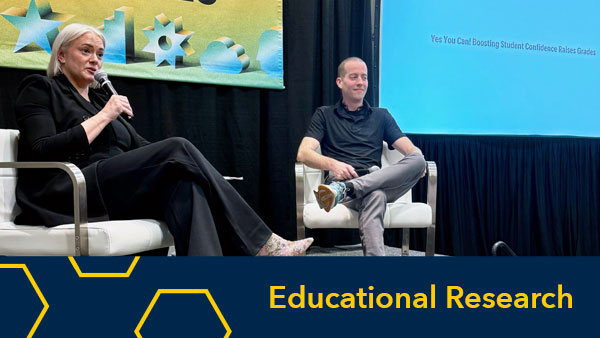James DeVaney, Associate Vice Provost for Academic Innovation
@devaneygoblue

In March 2018, U-M announced the intent to design three new innovative online and hybrid programs – one in the growing field of applied data science, a first of its kind in public health, and the first MasterTrack Certificate program, an advanced program in construction engineering and management. The Office of Academic Innovation also recently launched three MicroMasters programs, with the School of Information, School of Education, and School of Social Work, respectively.
As many of U-M’s colleges and schools seek to develop new online and hybrid credentials, we are adding to our capabilities and experience in this arena. I’m thrilled to welcome Sarah Dysart home to Ann Arbor as the new Director for Online and Hybrid Programs at the Office of Academic Innovation. Sarah is a graduate of the College of Engineering and the School of Education at the University of Michigan and spent the last 11 years at Loyola University Chicago, most recently as the Director of Online Learning.
Sarah brings a wealth of experience to our team as we accelerate our design of leading online and hybrid programs and create a flexible and networked model for global and lifelong learning that embraces the evolution of a more permeable university. Sarah shares our team’s passion and commitment to broadening access to high quality learning at U-M.
Sarah and I connected as she heads into her first week at the Office of Academic Innovation and discussed faculty development, student learning, and the joy of solving educational problems.
1. You are stepping into a new role with the Academic Innovation team as Director for Online and Hybrid Programs. What excites you about this next step in your career and what motivates you to solve problems at the intersection of teaching, learning, and technology?
I earned both my Master’s and Bachelor’s degrees from U-M, and I started my career working as a web programmer in the School of Dentistry, so this is somewhat of a homecoming for me. It’s exciting to be able to do work that I love and am really passionate about at the institution where I started my academic and professional career. I know how transformative my education at the University was for me personally; I’m excited to work with AI and academic units to provide broader access to the outstanding learning experiences created by U-M faculty.
Regarding what motivates me, my Bachelor’s degree is in engineering, and I’ve always loved problem-solving. Transitioning to the field of education as a graduate student was challenging because problems in education don’t have laws and formulas to help find precise solutions; educational problems are more messy, unpredictable, and complex than any engineering problem I’ve worked on. Berliner (2002) talks about educational research being “the hardest science of all,” and I couldn’t agree more. Contextual and individual student differences create constantly moving targets that make it hard to generalize results and determine what “works” for individual student learning. My job is awesome in that I get to attempt to solve these incredibly complex and complicated problems every day. No two situations are exactly the same, and every challenge is a fresh opportunity to figure out what works with a different set of variables.
2. How does your experience with faculty development inform the way you approach the design of new online programs?
Faculty are perhaps the most critical stakeholders when it comes to designing and developing new online programs. Their self-efficacy for teaching with technology and the factors that motivate them to engage in teaching online can be critical factors for the success of an online program. With that in mind, I like to emphasize building instructors’ self-efficacy for teaching online and reducing motivational barriers as high priorities when designing new online programs. Building self-efficacy can be achieved by creating opportunities to instructors to have their own successful experiences teaching with technology, or by observing what colleagues are doing successfully when teaching in online or blended environments (or vicarious experiences). To reduce motivational barriers, you first have to listen to and empathize with instructors’ concerns regarding teaching online. I often find that instructors’ motivation is tied to self-efficacy, but there are also frequently concerns regarding the time commitment required and how that will compete with other priorities.
3. As more universities engage in online education, which topics and questions aren’t getting enough attention?
Proponents of online education often talk as if it’s a panacea in terms of creating access to educational opportunities for traditionally underrepresented groups in higher education, but research suggests that underrepresented populations such as low-income and minority students are actually less likely to engage with online learning opportunities (Jaggars, 2012; Ortagus, 2017). We need to better understand why this is the case and how we can meaningfully support these students so they engage and persist with opportunities to learn online.
There’s also the really messy question of how we’re defining success in online education. Much of the literature focuses on student satisfaction as the key metric for success, and I think we’re somewhat missing the mark by not centering our definition of success around student learning.
4. What questions and activities do you hope to explore through your new role? How do you hope to work with faculty, staff, and student innovators?
In my work with faculty, I’ve seen evidence that teaching online can help facilitate the transformation of pedagogical approaches, but it’s not something that happens consistently. My research looks at how and why affordances and constraints created by the online environment can help instructors think differently about the way they teach; I’m interested in exploring how that impacts not only their online teaching, but also how it can improve the practices they use in the face-to-face environment.
I’m also really excited to work with faculty, staff, and students to create robust frameworks for providing online student support. The learning experience isn’t just about the curricular opportunities and coursework that’s offered online; participation in co-curricular learning experiences such as research opportunities or departmental programming (e.g. seminars and brown bags) and access to student services (e.g. mental health services and career counseling) can be critical factors for student success and learning. I’m excited to see how we can reimagine the total Michigan learning experience—beyond just the curriculum—for our online and hybrid students.
5. You have roots in Ann Arbor. What is the first thing you plan to do upon your return?
I always loved running the trails in the metroparks and state parks near Ann Arbor. I’m looking forward to exploring them again (especially the Potawatomi Trail) with my family. And of course, we already had sandwiches at Zingerman’s.
6. What else should academic innovation affiliated faculty, staff, and students ask you about?
I love finding ways to frame contemporary educational problems, such as those we find in online learning, with the theories that have been established and the research that’s been done in the fields of ed psych and ed tech. So feel free to pitch practical problems to me and I’ll think about ways it might be framed by literature I’ve read. Finding ways to bridge the research-to-practice gap is something I’m really passionate about, and I think it’s important to draw upon what we already know about learning; it can easily be applied to the new problems we’re encountering.
I also have a six-month old who makes the best facial expressions. If you ask for photos I will be happy to oblige.
Berliner, D. C. (2002). Educational Research: The Hardest Science of All. Educational Researcher, 31(8), 18.
Jaggars, S. (2012). Online learning in community colleges. In M. G. Moore (Ed.), Handbook of distance education (3rd ed ). New York, NY: Routledge.
Ortagus, J. C. (2017). From the periphery to prominence: An examination of the changing profile of online students in American higher education. The Internet and Higher Education, 32, 47–57. https://doi.org/10.1016/j.iheduc.2016.09.002


